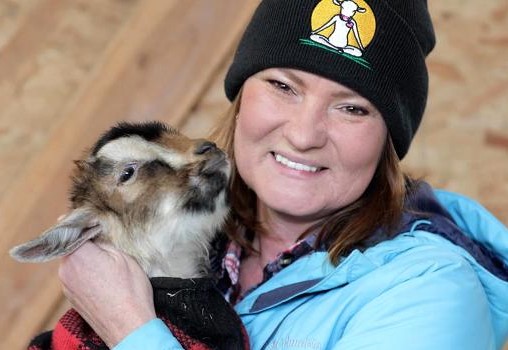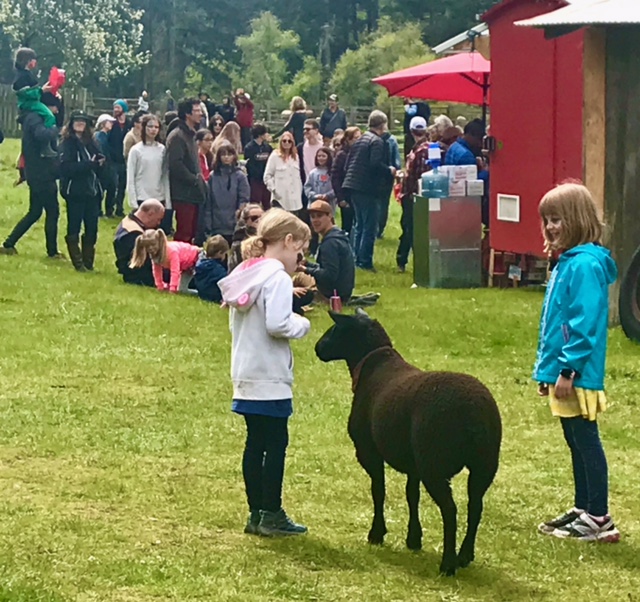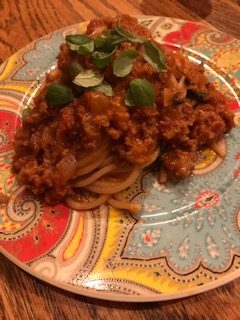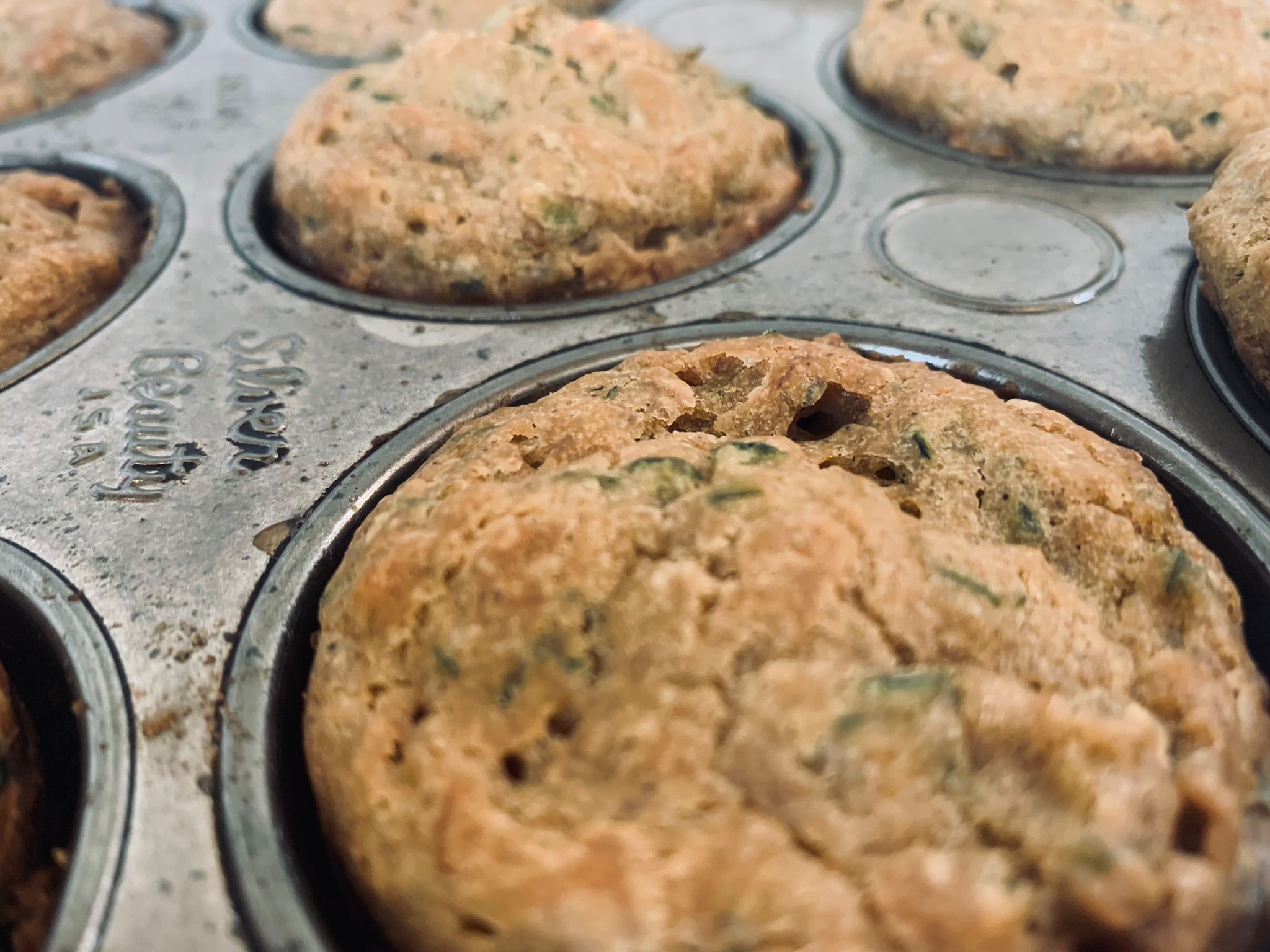When I first heard about Goat Yoga, I thought, as I imagine most people do, that it sounded like a fun and silly novelty experience. It wasn’t until I tried a class at Lemos Farm in Half Moon Bay, California, that I understood how this was more than an Instagram-able fitness class and really an experience of animal assisted therapy.
So many people are out of touch with nature and surrounded by technology and the demands of modern life. By allowing people the opportunity to connect with these adorable, affectionate animals while moving their body in nature, people can experience profound joy and relaxation.
The Original Goat Yoga was developed by Lainey Morse. A friend and I were all set to attend a class at their Morgan Hill, California, location when shelter-in-place was announced due to Covid-19 and all classes were cancelled. Sadly they were unable to reopen by the time I moved back to Canada in late January 2021.
Having over fifteen years of Pilates teaching experience, I have aspirations to perhaps teach my own Goat Yoga and Pilates class at Ruckle Heritage Farm and was disappointed that my reconnaissance mission wouldn’t be possible. I was delighted when Lainey generously agreed to talk with me and answer my questions via Zoom.
Abey: “So your name is Lainey Morse and you’re the one that started it all?”
Lainey: “Yup. Oddly enough ,what a crazy ride this has been.”
We went on to talk about how her business had shut down due to Covid-19 restrictions when they were set to have their best year yet. While other organizations chose to be open, at the time of the interview they were “holding tight” and planning to reopen in the spring. I went on to ask Lainey about the history of Goat Yoga.
Lainey: “I started something called Goat Happy Hour in 2015 and that’s what started goat yoga. I’d been diagnosed with a disease and my life was a mess. I worked a corporate job and everyday when I’d come home I couldn’t wait to get out to the barn and just sit out in the barn or in the field with my goats. They were just so calming to me that I just craved it. I just couldn’t wait to get up in the morning and I hated going to work. It just helped me. I started inviting over friends I knew who were having a hard time, or friends would call and say ‘I just need a distraction”. It became quite the thing in my little town.”
Abey: “And what town was that?”
“At the time I lived in Albany, Oregon. It was just a lot of fun. It didn’t matter if people weren’t animal people. By the time they left they were just like ‘this is really cool’ and they left smiling. So that’s why I called it Goat Happy Hour. One of those people that came to the happy hour was a yoga instructor and we’re just standing out in the field and she’s like “Man it’s gorgeous out here. You should let me have a yoga class”. And when you’re doing chores in the barn and you’re leaning over and the goats are jumping on top of you it’s kind of annoying [laughs] so I was like ‘You know the goats are going to be all over the humans’ and she’s like ‘cool!’
“I had been in marketing and so I started marketing it as goat yoga and initially I just thought my close friends and family would come to something like this but within…let’s see, by July, it had been a month, all of a sudden, it just started growing. Like I would get 400 people interested and I’d be like [gasps], ‘I can’t have this many people!’ so it took a more structured way to do things, like getting people to register through Eventbrite, not just ‘Hey, come to my farm’ so that started that whole journey. But it was a very difficult one. It was quitting my corporate job after I had 2000 on a waitlist to come to my farm and I thought, “Hey, there’s something to this.
“At this point that I quit my job in November 2016 it’s winter time in Oregon and it rains a lot and I thought I can’t have a lot of classes right now so the hunt was on to find liability insurance for something like this and that’s where I hit a wall. No one would insure goat yoga.
“These insurance companies were like we don’t have any data that shows it’s dangerous. Everyone denied me. The insurance that I finally did get was so expensive that it was ridiculous. I was like ‘What? They’ll insure rodeos but they won’t insure goat yoga?’
Abey: “So what did you end up doing?”
Lainey: “I bought the expensive insurance because you know, if you have events, especially corporate events- we were doing health and wellness events for employees and they require you to have liability insurance to even do their events. So that really became our biggest money maker was doing corporate events. We were going to Google’s campus every month and Facebook and Nike. Huge corporations. But the liability insurance was just crazy. I require all my locations to have liability insurance and it’s pretty equally expensive throughout the states. You definitely want it.”
Abey “Yeah, wow, you need to protect yourself. What were some of the other unforeseen challenges or thing you wish you’d known at the beginning?”
Lainey: “Right at the beginning the USDA stepped in and they didn’t know if I would be under them or not. They would require all these really tough…they would have to come inspect your facility, make sure you’re feeding the goats right, that they have a vet, that you’re transporting them correctly and safely. It was just going to be a huge ordeal. But finally they decided that I wasn’t under their umbrella but that took a lot of time too. So that first year was basically just fighting every institution just trying to dosomething like goat yoga on my property, which was so silly to me because at that time it wasn’t about getting a goat on your back, like it is now. It was just about doing yoga with the goats around. They would just lay on your mat or snuggle you and I think since then it has taken on a new persona but it just seemed like everyone was saying no because they were judging something they didn’t understand. I still can’t do goat yoga. I’ve moved my property in the hopes of creating a commercial farm…..they won’t let me do goat yoga on my property even currently because if I were to slaughter the goats or milk them I’d be able to because I’d be providing a product but since I’m just doing yoga with goats that’s not a farming product. So my zoning is not correct. So I have to make a commercial farm out of my property that makes more than I would doing goat yoga. So these are the rules. I don’t know if everyone gets the proper permitting and liability insurance but it’s definitely worth doing things legally because you don’t want to invest $100, 000 in a business and then find out you can’t do it.”
Abey: “Do people bring up concerns about it being humane and how do you respond to that?”
Lainey: “Yes, that first year that’s another thing I had to deal with and another reason I had to move. I had PETA people stopping at my home. I had a goat yoga van that I would transport the goats in and my daughter had it one night and someone followed her home to my house and screamed at her because we were making money off goats and it wasn’t humane. Made her cry. I was just like’ Oh my gosh, I had no idea this would happen.’ I had all these vegan groups go to war with me. It was devastating to me because my goats are about the most spoiled goats in the world and they’re my kids. It was just amazing how mean people were. All the comments online: that I was a cult leader or a typical white middle aged woman [laughs]. They went on and on. You can’t imagine the things they said. I’d pour myself a glass of wine at night and go on Youtube and read the comments. People are nuts. But it’s since calmed down. I haven’t been contacted in probably a year, at least. I tell people they have to vet each business. We estimate now there’s probably over 500 goat yoga business out there and each one is different . All my locations have to attest that their goats aren’t sold for meat, that they’re not over breeding, that they’re in their forever homes and they have vet care. That’s the requirements to be an Original Goat Yoga location. I see a lot of dairy farms that breed every year and people come and do their classes with their baby goats and then they go away…and where do they go? That’s my concern right there.You just have to vet each business and see if they’re doing it as a cash cow or if their intentions are that these goats are good for our mental health. They’re therapy. They’re so much more than just meat or milk.”
Abey: “How old are they usually when they start with you? And it sounds like for you they’re there forever. Are they in the classes forever or do they ever age out of that?”
Lainey: “Nope. I believe that the adult goats are even better at therapy than the baby goats. I mean, everyone loves a baby goat and they’re adorable, they jump all over, they want to be on you. There’s just nothing cuter. I usually go to a farm and if they’re sold as meat I’m going to rescue that goat. I have to have a limit on how many goats I can have here. And any baby goat that comes here I could never part with it. So my rule is I can have thirteen goats and I don’t breed and once they’re older they’re just as loving. You put a yoga mat down and they just want to lay on it with you. They’re not the type of goats that jump on your back anymore. They did when they were babies but now they’re really good therapy goats and it’s just about getting outdoors and surrounding yourself with these loving animals and disconnecting from everything and so the age doesn’t matter”
Abey: “And is there anything you’re doing to train them to be part of the class or is it just their nature?”
Lainey: “You know it’s their nature. They love humans. They love attention. But the main thing you do have to do is spend time with them. You have to put love into them. And me personally, I go out in the morning and as long as it’s not raining we go for a walk around my property all together. The dogs, the pigs and then at night we do the same thing. I don’t watch TV anymore. When I got goats I cancelled cable [laughs]. I spend most of my time just hanging out in the barn. If you put that time into them they’re going to be really friendly. Goat Yoga isn’t going to be much fun if your goats aren’t friendly and their skittish and they don’t want to be by you. You just have to put the time in and you’ll have very attention seeking goats.”
Abey: “When you do a class how many goats to participants do you have? And how many people supervising the situation?”
Lainey: “We go by a ratio of three to one. Three humans to every goat. But since Covid that’s probably going to change. We used to let thirty people come to our classes and I think I’ll probably have much smaller classes now. Maybe ten people. So that’s a goat per person. I think the days of the big classes are probably over for a bit. We’ll figure that out. Most of our big corporate events were a lot of people so I don’t know how we’re going to recover from that part of it. And now everyone works from home so the employee health and wellness events will not be plentiful.
Abey: “Oh right….”
Lainey: Oh I forgot to answer how many people I have. I have the yoga instructor and I then have one other person who is taking pictures of the class. People love to have those shots. And if a goat pees on someones yoga mat, it’s immediately swapped out for a new yoga mat or if a goat poops on someone’s mat you quick clean up and joke about that. The yoga instructor will always say something like, ‘Oh you’re the lucky chosen one.’ You have to have a sense of humor about it. I usually have one person who helps transport them. I brought my goats to a winery and then a bed and breakfast. We built areas at both those locations where we could just back up our van, open the doors and the goats could go in. I was very sick at the time so everything had to be very easy to do so that even I could do it. So it was usually three people at each event but you could really get away a small event having one person plus the yoga instructor. You also want people to help with parking and signing in and all that.”
Abey: “And are classes usually an hour?”
Lainey: “Yeah. About an hour. We tried an hour and a half at the start because the yoga instructor is usually used to doing an hour and half class. What really happened was that people who were coming to the classes were people who’d never been to a yoga class and they really didn’t care about the yoga part so we shortened the class to thirty minutes. Plus the goats, they kind of lose interest after a whole hour too. Then they start getting in trouble. Goats are very mischievous so you have to keep them focused. So thirty minutes of goat yoga and then thirty minutes of goat happy hour. Which was basically taking pictures for people, telling people educational things about the goats. Just letting them relax and spend time with them.”
Abey: “Nice. That sounds great. And does gender play a role at all? Do you have male and female goats?”
Lainey: “Yes, good question. I have ten male goats and two females. My first female Ansel and Adams, those were my first two goats. I had Ansel bred at the beginning because I didn’t know any better and I thought, ‘I’m going to have baby goats’ So she had one daughter Annie and Annie was really the one who inspired the whole idea of goat yoga. So she’s my logo [points to her knit cap] and she’s the last baby goat I’ll have at this farm, or that’s born at this farm anyway.”
Abey: “Because you’re wanting to rescue grown goats?”
Lainey: “Yeah, so male goats, not necessary grown goats, but the male goats at farms usually they’re the first ones to get slaughtered because if they aren’t a good breeding goat then it’s just cheaper for them to slaughter them and feed them to their guardian dogs or put it in the freezer. So it’s more time consuming for them to list them to sell them as a pet for $75. I have ten males now that were all rescued. That’s what I’ll always do. My favorite goat, he died last year, he got a bad disease, so I have room for one more goat right now but I’m just waiting for that special one”
Abey: “Do you feel this is often a one-off experience for people or how do you create an environment that keeps people coming back?”
Lainey: “Well I do know that most of the people that came were one timers. It’s a very tourist driven activity. A lot of people that would come would say, “This is my family from California, or my friends of family that are visiting.’ We did have people who would come over and over but it was more so the one-offs. They needed to experience it or they had a special occasion going on. We did a ton of bachelorette parties, birthday parties. It was definitely a tourist driven thing. In fact we came up with a formula that we wouldn’t accept people for locations if they didn’t have enough population around them or a tourist destination that it wouldn’t have been worth it to even start up a location there. You needed to have at least 200-800 000 people in a twenty or thirty mile radius and it needed to be millennials mostly, are the age group, and women.”
Abey: “Is there anything else you’d like to share?”
Lainey: “You know the type of goat, a lot of people use Nigerian Dwarf or Pigmies because they’re smaller, they’re easier to take care of, you don’t need as much room. Most of my goats are Nigerian Dwarf. I do have one Nubian who is a larger goat, he’s a special needs goat. And then I have two rescue goats that Boer goats. They call them meat goats and they get pretty large. Like 200 pounds plus but I have to say that those Boer goats are my most affectionate, loving goats and anyone that comes to this house, they all say that those two goats are their favorite. So it doesn’t matter their size, they’re still very- they’re still my goat yoga goats. They take up a whole yoga mat now! [laughs]. They like stare into your soul. We’ve said we’ve repurposed them from meat goats to therapy goats. So if you’re going to start something like this, make sure you get some meat goats.”
Abey: “Wonderful. The animal assisted therapy side of it is really fascinating to me. So I’m excited to learn more about that.”
Lainey: “Yeah, it’s been fun. Even though I’m not doing goat yoga right now I’ve been doing the goat happy hours. So I have people come to the farm. It’s usually two people at a time. We mask up when they get here and I take them for a loop around the farm and the goats follow us and then I just leave them be to wander the farm with the animals. They get to experience what I get to experience all the time, that time alone, just out in nature with those animals. We’ve had people come whose family has died of Covid, or are in the hospital or they’ve lost their job. I’ve heard just so many just heartbreaking stories and they would say, ‘You know, just spending time here was more beneficial than being on a psychiatrist’s couch, I’ll tell you that’. So I know animal assisted therapy, it works and these animals are human’s natural medicine for us. So I hope that a lot of the other goat yoga businesses will not be so driven to just snap that goat on your back picture. I’m kinda disappointed that’s where it is, just kind of an Instagram grab. I need for them to realize it’s more than that. That’s why if you look at pictures of my original classes you’ll never see a goat on the back [laughs].”
Abey: “And are your classes usually outside or were you doing them inside?”
Lainey: “I prefer the classes to be outdoors. I do have some locations that do it in their barn. When you are running so many classes you have to have an area that has cover because to have to cancel class every single time it rains or there’s something weather related, people start to get angry even though it’s not your fault. So you have to have cover.”
Abey: “Okay, so it’s outside but with some sort of cover like a tent or something?”
Lainey: “Yeah I’ve used event tents. I prefer barns just because it has a better feel to it but event tents are fine. I’m not real keen on yoga studios just because it feels like you’re bringing the goats into the human level instead of you going into the goat realm, you know. There’s nothing like laying on a yoga mat and looking into the sky, just listening to the wind and the birds and there’s a goat chewing on your ear.”
We finished out discussion talking about my move magical Ruckle Heritage Farm on Salt Spring Island and my hope to blend what I know of fitness with animal assisted therapy and help people reconnect with nature. She said “Wow, it sounds like such a dream!”. Indeed it is!





